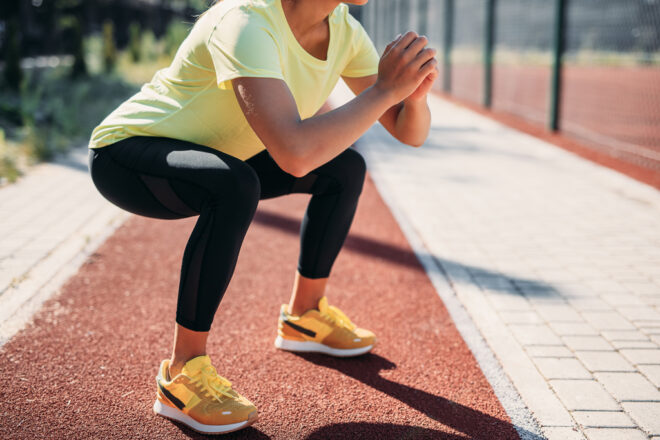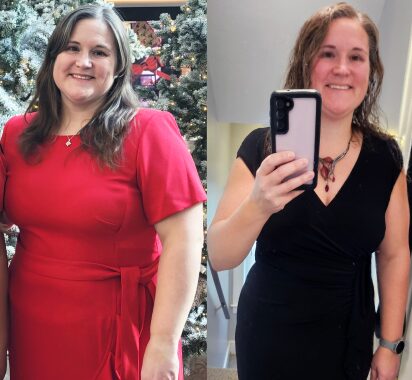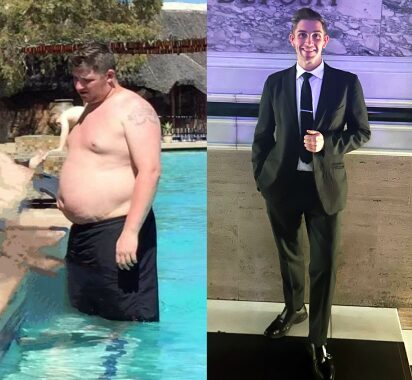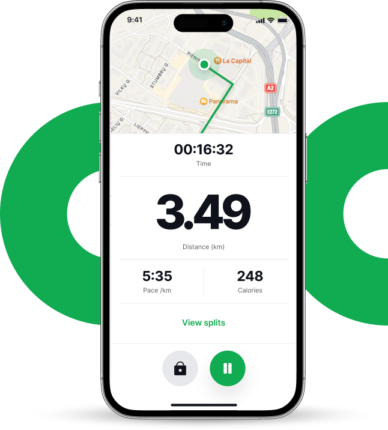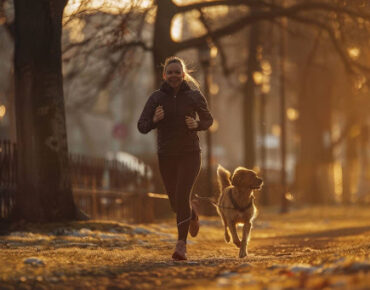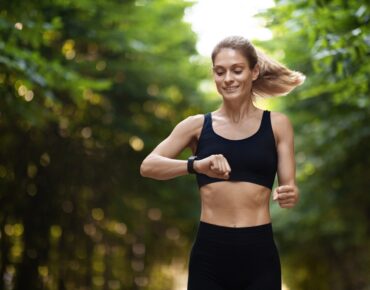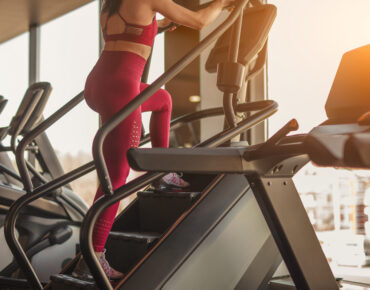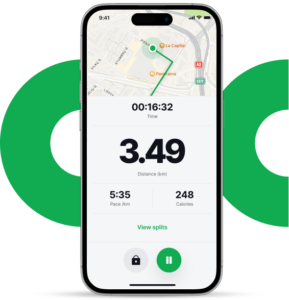You probably do squats every day, whether you realize it or not. Every time you sit down or tie your shoelaces, you’re essentially squatting.
Squats strengthen your leg muscles. Strong leg muscles don’t just make you a better runner. It increases the ease with which you perform everyday movements.
Squats are also one of the best exercises for toning your butt. Do squats make your butt bigger? You bet they do.
But to reap the benefits of squats, you have to do the exercise correctly and often enough.
So, should you do squats every day? Should you aim to do 100 squats a day? Read on to find out.
In This Article
In This Article:
What Is a Squat?
A squat is a simple and effective bodyweight exercise for strengthening and toning the lower body.
In a basic squat, you start from a standing position and lower your hips toward the floor. You then return your body to the starting position to complete one repetition.
A basic squat engages all the major muscles in your legs, including your glutes, quadriceps, and hamstrings. It also engages your abs, which contributes to a stronger core.
How Do Squats Benefit Runners?
Bodyweight squats, when done correctly, can benefit runners in more ways than one. From making you a faster runner to working out your core, here are the best reasons to add squats to your workouts.
- Builds a stronger gluteus maximus. Squatting is one of the best exercises for developing a strong gluteus maximus muscle. This muscle plays a key role in propulsion and speed when running.
- Reduces the risk of major running injuries. Doing squats regularly builds your lower body muscles. Weak lower body muscles have been associated with a higher risk of injury in some runners.
- Strengthens knee and ankle joints. Studies show that squats can make your lower joints stronger. As a runner, having strong joints may reduce the risk of stress-related injuries.
- Burns fat. A study on 94 adolescents found that squat training for 8 weeks decreased body fat by 4.2%. If you want to build muscle and burn fat, squats are an exercise you can add to your workout. Take a look at these photos of cellulite before and after squats, and you’ll see the difference.
- Strengthens your core. Squatting activates key core muscles like the erector spinae, rectus abdominis, and external oblique muscles. A strong core means better stability when you run and can contribute to an efficient posture.
- Rounds your butt. This may not be a priority for all runners, but if you run to lose weight and tone your body, it’s well worth adding. Through its effects on the gluteus maximus, regular squatting can lift and round out your butt.
How to Get Started
Not used to squatting? No problem. Bodyweight squats are manageable if you do them correctly and don’t push yourself too hard too soon.
Start with the basic squat, which we explain in the next section of this article. Here are a few important things to keep in mind before you start working out:
- Keep your back straight.
- Engage your core as you perform the movement.
- Make sure your knees are at a right angle as you lower your hips.
- Going all the way down during a squat works the gluteus maximus the most. This is the main buttock muscle.
- The deeper you squat, the harder the workout. But if you can’t squat deep from the start, that’s okay. Aim to gradually increase the depth of your squats.
- Aim for 2–3 sets of 15 squats each.
Modifying Squats
Mastering the basic squat is crucial before moving on to more challenging variations, such as jump squats, split squats, or cup squats.
Despite its simplicity, it’s easy to go wrong with the basic squat if you rush it or don’t pay enough attention to your posture while performing it.
Next, let’s see how to do basic bodyweight squats with perfect form before moving on to more challenging variations of the exercise.
Basic squat
- Place your feet shoulder wide and arms down at your sides.
- Engage your core and hinge at the knees, pushing your hips back. Keep your back straight, and make sure your knees don’t drop in.
- Continue the downward motion until your thighs are parallel to the floor, then pause for a moment.
- With a controlled motion, push yourself back up through your heels to complete one rep and return to the starting position.
- Perform 2–3 sets of 15 reps each.
Tip: As a variation to the basic movement, you can lift your forearms at the elbow as you come down and bring your hands together. As you stand back up, let your arms fall to your sides.
Jump squat
- Stand with your feet shoulder wide and arms at your sides.
- Drop to a squat with arms at your sides.
- Jump up with an explosive motion, raising your arms above your head.
- Land back down into a squat position with your arms at your sides to complete one repetition.
- Jump back up without pausing and continue jumping and squatting until you complete all reps.
- Start with 2 sets of 15 reps.
Split squat
- Start with one leg in front and the other behind in a wide stance.
- Place your arms at your sides.
- Bend your knees until the back knee touches the floor, engaging your core and keeping your back straight.
- When your front thigh is parallel to the floor, pause for a moment.
- Return to the starting position to complete one rep.
- Complete all reps with one leg before switching legs.
- Aim for 2 sets of 15 reps each.
Goblet squat
- Grasp one end of a dumbbell and hold it in front of you, elbows bent so that it touches your chest. Your hands should be cupped around the dumbbell.
- Make sure your feet are slightly wider than shoulder width.
- Bend your knees and push your hips back while looking straight ahead. Hold the dumbbell firmly, so it doesn’t move.
- When your thighs are parallel to the floor, pause for a moment.
- Return to the starting position by pushing through your heels to complete one rep.
- Perform 2–3 sets of 15 reps.
How Many Squats Should I Do a Day?
You may have heard of workouts that promise great results if you do 100 squats a day. Or others that encourage you to squat every day.
The truth is, there is no magic number that works for everyone. How many squats you do each day depends on your age, weight, fitness level, and goals.
- As a beginner, a safe approach is to start with 2–3 sets of 15 reps every other day.
- You can increase to 3 sets of 20 reps every other day as you get into better shape.
- As a fitness challenge, you can do 100 squats every day for 30 days.
Combining different types of squats can lead to better results than simply doing the basic squat over and over again.
Also, don’t focus on squats to the exclusion of other exercises. Combine squats with other bodyweight, strength, and running exercises to work your body and improve your fitness level.
Important: Remember to warm up before squatting to reduce the risk of injury. A good warm-up combines cardio with dynamic stretching.
Takeaways
Before you start adding squats to your workouts, here are the things to remember:
- Regular squats can make you a faster runner.
- Include regular squats in your training to reduce your risk of running injuries.
- The deeper you squat, the more you work your glutes.
- How many squats you do per day depends on your fitness level and weight – start with 2–3 sets of 15 repetitions.
- You don’t have to do 100 squats a day or squat every day to see results.
Finally, by increasing the depth and volume of your squats, you can adapt the exercise to all fitness levels. This makes squats a versatile and reliable exercise to add to your workout.
Frequently Asked Questions
How many squats should I do a day to see results?
The ideal number of squats for achieving results varies depending on your fitness level, workout goals, and recovery capabilities. A general recommendation for beginners is to start with 3 sets of 10-12 repetitions. As you become stronger, you can gradually increase the number of sets and repetitions. Additionally, experimenting with different squat variations like sumo squats, pistol squats, and Bulgarian split squats can provide a more comprehensive workout and enhance muscle engagement.
It’s crucial to pay attention to your body’s signals and incorporate rest days to prevent overtraining and potential injuries. Following a proper warm-up routine, incorporating dynamic stretches, and performing squats followed by static stretches for the hamstrings and quads can ensure a well-rounded workout. Remember to adapt this workout plan to suit your individual fitness level and objectives.
What happens if I do 100 squats a day?
Doing 100 squats a day can provide several benefits for your overall health and fitness.
Increased Leg Strength and Muscle Tone: Regularly performing squats engages the major muscle groups in your lower body, including your quads, hamstrings, glutes, and calves. This repetitive movement can help build strength and tone these muscles, resulting in a more defined lower body.
Improved Posture and Balance: Squatting strengthens the muscles that support your spine and core, which can lead to improved posture and balance. Strong leg muscles can help you maintain proper alignment and reduce the risk of falls.
Boosted Metabolism and Fat Burning: Engaging in regular exercise, especially strength training, can enhance your metabolism and promote fat burning. Squats are a calorie-burning exercise that can contribute to overall weight management and a leaner physique.
Reduced Risk of Osteoporosis: Squatting exercises put stress on your bones, which can stimulate bone growth and density. This can help reduce the risk of osteoporosis, a condition characterized by weak and brittle bones.
Enhanced Cardiovascular Health: Squatting can also improve your cardiovascular health. As you perform squats, your heart rate increases, promoting better blood circulation and oxygen delivery throughout the body. This can contribute to a lower risk of heart disease, stroke, and other cardiovascular problems.
Mental Well-being Benefits: Engaging in regular physical activity, such as squats, can have positive effects on your mental well-being. Exercise releases endorphins, which have mood-boosting and stress-reducing properties. Squats can help reduce anxiety, improve sleep quality, and promote overall mental health.
To maximize the benefits of 100 squats a day, it’s important to maintain proper form and technique. Start with a beginner’s level and gradually increase the number of repetitions as you get stronger. Don’t forget to include proper warm-up and cool-down routines to prevent injuries.
Is 20 squats enough for a day?
Whether or not 20 squats are enough for a day depends on your fitness level and goals. For beginners, doing 20 squats a day can be a great way to start building strength and endurance. However, if you are looking to see more significant results, you will need to gradually increase the number of squats you do over time.
How many squats should I do a day to get a bigger bum?
The number of squats you need to do to get a bigger bum depends on several factors, including your current fitness level, workout goals, and recovery time. However, a good starting point is to do 3 sets of 10-12 repetitions of bodyweight squats.
How long does it take to see results from squats?
It can take several weeks or months to see significant results from squats. However, the more consistently you work out, the faster you will see results.
How many squats a day should I do if I’m overweight?
Start with 2 of 12 basic squats a day to get into shape while reducing the risk of injury. Gradually increase to 3 sets of 15 reps each.
How many squats should I do in a day if I’m already following a workout plan?
You can easily integrate 2–3 sets of 15 squats into most workout plans. For best results, follow a personalized training plan.
How many squats should I do if I combine different types of squats?
Do a set of 15 reps for each squat variety, or follow the instructions in your personalized training plan.
How many squats a day should I do to see results?
Your lower body and core will get stronger if you do 3 sets of 15 reps every other day for several months.
References:
- Escamilla, R.F., 2001. Knee biomechanics of the dynamic squat exercise. Medicine & science in sports & exercise, 33(1), pp.127-141.
- Rahmani, A., Viale, F., Dalleau, G. and Lacour, J.R., 2001. Force/velocity and power/velocity relationships in squat exercise. European journal of applied physiology, 84, pp.227-232.
- Comfort, P. and Kasim, P., 2007. Optimizing squat technique. Strength & Conditioning Journal, 29(6), pp.10-13.
- Conner, C. and Poor, G.M., 2016, May. Correcting exercise form using body tracking. In Proceedings of the 2016 CHI Conference Extended Abstracts on Human Factors in Computing Systems (pp. 3028-3034).
- O’Reilly, M., Whelan, D., Chanialidis, C., Friel, N., Delahunt, E., Ward, T. and Caulfield, B., 2015, June. Evaluating squat performance with a single inertial measurement unit. In 2015 IEEE 12th International Conference on Wearable and Implantable Body Sensor Networks (BSN) (pp. 1-6). IEEE.

